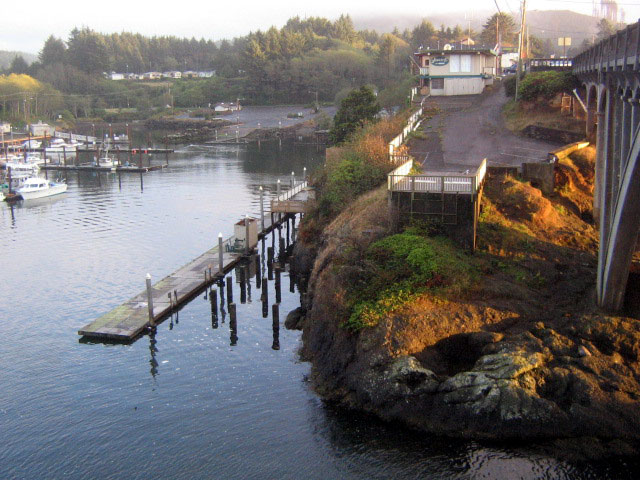Oregon Coast Oddities You Almost Know: Gold, Fossils, Weird Plants, Nebulous Claims
Published 07/09/22 at 3:09 AM PST
By Oregon Coast Beach Connection staff

(Oregon Coast) – It's a wide world of surprise oddities on these beaches. These shores present some wild finds in nature – sometimes millions of years old – and discoveries in how mankind has categorized things out here. Getting to know the Oregon coast better always means a few raised eyebrows. (Above: photo Oregon Coast Beach Connection)
Blobs of Bulbous Bulbs. What are those massive piles of tube-like things on the Oregon and Washington coast? They're more or less plants: they're called bull kelp and are essentially large brown algae that grow in “forests” just offshore.
According to the Hatfield Marine Science Center, these kelp are annuals, completing their life cycle in one season, and can grow up to 20 meters (60 feet) in one year. At the bottom, their branching "holdfasts" anchor the kelp, although some are torn free in storms. Their long stipes (stems) tangle together to form large piles, as you see in the photograph. Their floats have a high proportion of carbon monoxide and to keep the blades (leaves) near the surface for photosynthesis. Their smooth, roundish shapes, when bobbing in the ocean, are sometimes confused with seals. Full story here.

Gold Beach's darker sands, courtesy Gold Beach Visitors Center
South Oregon Coast's Real Gold Around Gold Beach. It turns out Gold Beach got its name for a reason: there really is gold in them thar beaches. Even to this day it still exists.
These are minuscule specks, however, and nothing that will get you rich. However, you will get sore just trying to get anything. Sifting sand around here is back-breaking, boring work, but it's still done recreationally, and there are some who actually eek out a small profit.
Look for the black sands of the area, not just in Gold Beach but from Cape Arago down through Bandon and into Gold Beach.
It all hit about the same time as the big gold rush in Cali, and there was even an operational mine near Bandon at one point. Geologists believe these tiny bits come down from the Rogue River and the larger lodes to the east, washed down by rivers and streams.

Broken and Debunked Records of the Oregon Coast. Claims of records being broken along the coastline are many, along with some exaggerated proclamations of biggest or whatever. Some just are not true. (Above: Depoe Bay)
One that definitely is true resides just north of Florence. Sea Lion Caves is the largest sea cave in the world. The Guinness Book of World Records confirmed that in the '90s, noting the cave clocked in at 310 feet long, 164 feet wide and about 50 feet high.
On and off, Lincoln City claimed the D River is the shortest in the world, and there's likely still the same sign there. That isn't exactly true, and the reasons that claim was made goes back decades. Oregon Coast Beach Connection checked with the Guinness people back in the 2000s and confirmed there was no such designation given to the town – or its supposed competitor, a river in Montana.
What's the world's smallest navigable harbor? Well, it isn't exactly Depoe Bay as their sign says. There technically is no such official category for that. But it's still one cozy cove, and getting in and out is no easy feat.

Finally, what’s the shortest lighthouse on the west coast? That's Cape Meares, near Tillamook, clocking in at a stumpy 38 feet high. However, the north Oregon coast icon stands on a 217-foot-high cliff, thus ending up as the tallest sentinel here.

Beach Fossil Fun. There are tons of ancient, solidified creatures millions of years old just floating around beaches of the Oregon coast and in rocks around the region – even the cliffs. However, it's illegal to dig anything out of a surface: you have to wait until they've shaken themselves loose by time and tides. (Above: Fogarty Beach)
They're much easier to find in winter when sand levels get low and expose bedrock or agate beds. Newport's Moolack Beach is notoriously smothered in them. When the dark bedrock shows, you can see hundreds of shapes inside within a few feet of you.

Cape Arago near Coos Bay, courtesy Oregon's Adventure Coast
According to local experts, Oregon's "beaches are home to one of the heaviest concentrations of 15- to 30-million-year-old fossils in North America." Some of the best shell locations are at Charleston near Coos Bay, north of Florence at Strawberry Hill, the small parking lot north of Seal Rock and the section of beach just north of Ona Beach State Park (near Waldport.)
Oregon Coast Hotels in this area - South Coast Hotels - Where to eat - Maps - Virtual Tours
Cannon Beach Lodging
Nehalem Bay Lodgings
Manzanita Hotels, Lodging
Three Capes Lodging
Pacific City Hotels, Lodging
Lincoln City Lodging
Depoe Bay Lodging
Newport Lodging
Waldport Lodging
Yachats Lodging
Oregon Coast Vacation Rentals
Oregon Coast Lodging Specials
More About Oregon Coast hotels, lodging.....
More About Oregon Coast Restaurants, Dining.....
LATEST Related Oregon Coast Articles
Back to Oregon Coast
Contact Advertise on Oregon Coast Beach Connection
All Content, unless otherwise attributed, copyright Oregon Coast Beach Connection. Unauthorized use or publication is not permitted



















































